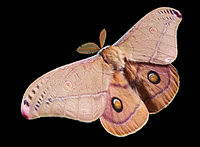Clothes Moth Fact and Fiction
I hear this question all the time, and almost always the answer is "no!" Of the 12,000 or so moth species in North America, only a few qualify as clothes moths, and it's only these species that actually use your woolens as a lunch counter. Virtually all moths and butterflies feed outside on plants, not inside on sweaters, and in addition it's only the caterpillars that do the eating.
This beautiful insect is the "emperor gum moth," a typical moth that is both beautiful and completely incapable of putting holes in your clothes. The caterpillars eat leaves, and the big, handsome adult eats nothing -- as in nothing. It doesn't even have fully-functioning mouthparts! That's because in the butterfly and moth world, the caterpillar is responsible for eating, and the adults are responsible for reproducing. Caterpillars don't reproduce. Moths often don't eat, and never get bigger once they hatch out and fly around.
This guy, on the other hand, is willing and able to ruin your scarves. More correctly, it's the little white caterpillar that is the larval stage of this moth who has an appetite for destruction. The moth eats little or nothing, and only wants to reproduce. But once it reproduces and lays eggs, those little eggs hatch out into destructive little caterpillars, and they immediately get busy, building little silk shelters and eating almost any organic fiber, including cotton, wool, camel hair, angora, and so on (they don't eat "inorganic" fibers like nylon and spandex). They also happily eat silk, which is ironic given that silk is itself a product of another moth species, Bombyx mori.

Here's an adult moth next to the case that the caterpillar hides in. You can also see a little white caterpillar at the bottom of the picture. That's the larva, and that'sthe culprit if "moths" are eating
your stored textiles.
I hear this question all the time, and almost always the answer is "no!" Of the 12,000 or so moth species in North America, only a few qualify as clothes moths, and it's only these species that actually use your woolens as a lunch counter. Virtually all moths and butterflies feed outside on plants, not inside on sweaters, and in addition it's only the caterpillars that do the eating.
This beautiful insect is the "emperor gum moth," a typical moth that is both beautiful and completely incapable of putting holes in your clothes. The caterpillars eat leaves, and the big, handsome adult eats nothing -- as in nothing. It doesn't even have fully-functioning mouthparts! That's because in the butterfly and moth world, the caterpillar is responsible for eating, and the adults are responsible for reproducing. Caterpillars don't reproduce. Moths often don't eat, and never get bigger once they hatch out and fly around.
This guy, on the other hand, is willing and able to ruin your scarves. More correctly, it's the little white caterpillar that is the larval stage of this moth who has an appetite for destruction. The moth eats little or nothing, and only wants to reproduce. But once it reproduces and lays eggs, those little eggs hatch out into destructive little caterpillars, and they immediately get busy, building little silk shelters and eating almost any organic fiber, including cotton, wool, camel hair, angora, and so on (they don't eat "inorganic" fibers like nylon and spandex). They also happily eat silk, which is ironic given that silk is itself a product of another moth species, Bombyx mori.

Here's an adult moth next to the case that the caterpillar hides in. You can also see a little white caterpillar at the bottom of the picture. That's the larva, and that'sthe culprit if "moths" are eating
your stored textiles.
More Questions about Household Bugs? Click here for a ton of photos and information!
all images courtesy of wikimedia commons


How does one get rid of these months and their larva once you find them flying out of your coat closet?
ReplyDeleteThis article is an appealing wealth of informative data that is interesting and well-written. I commend your hard work on this and thank you for this information. You’ve got what it takes to get attention. sub zero door adjustment
ReplyDelete